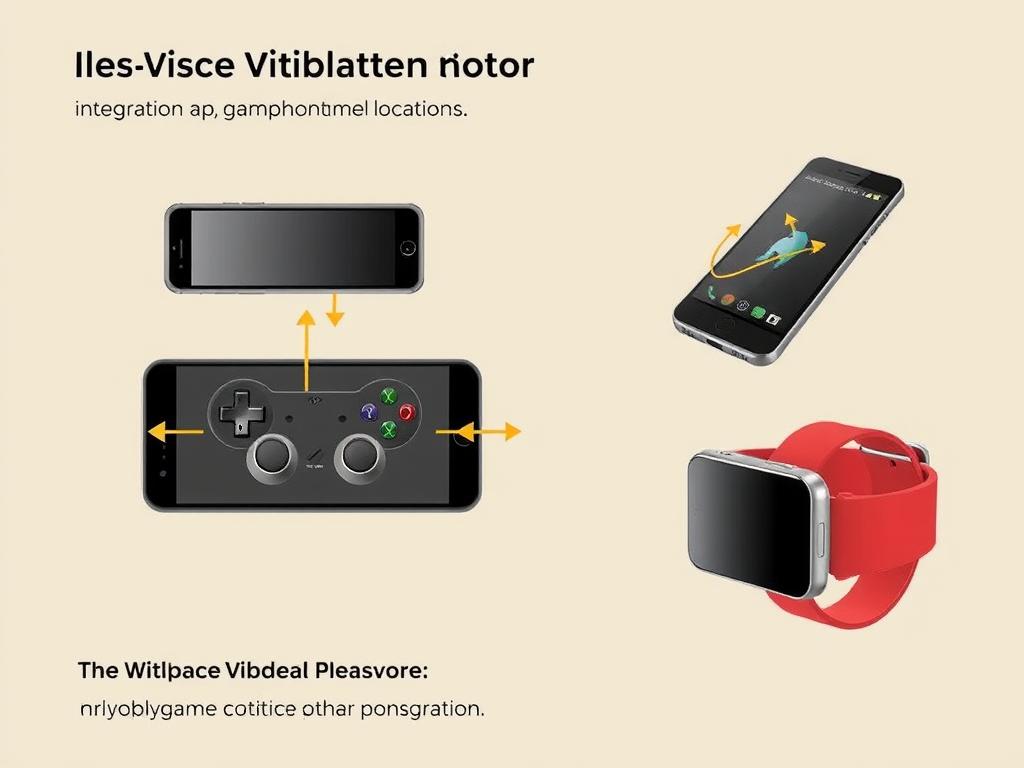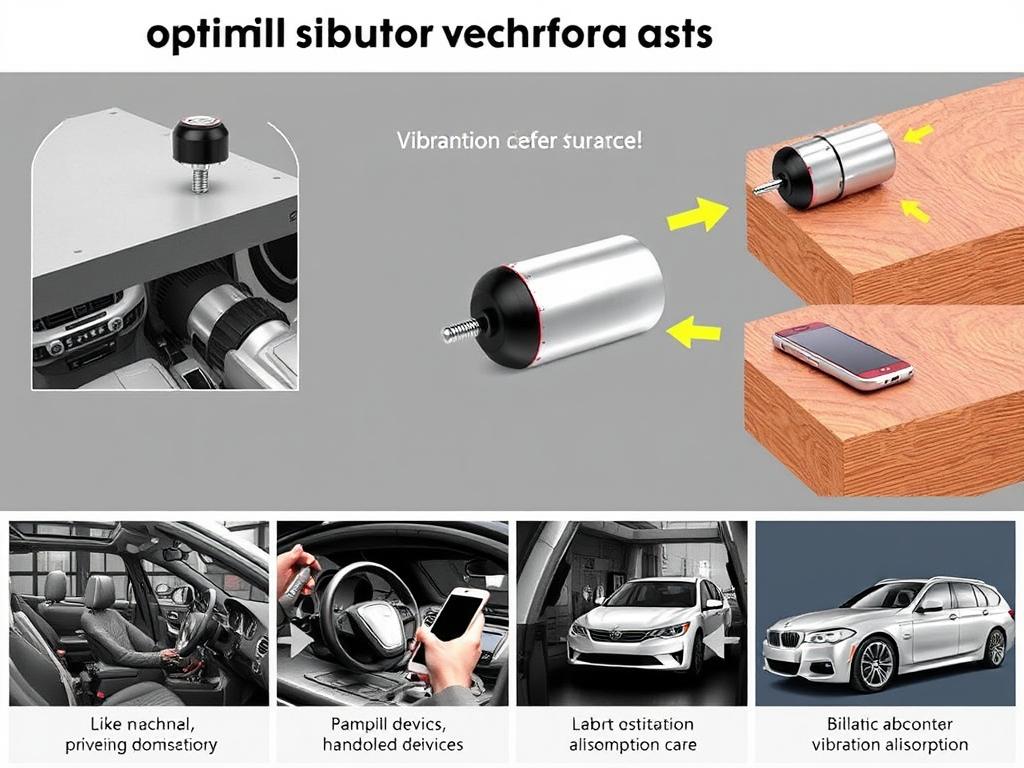“The secret of getting ahead is getting started.” – Mark Twain
I’m excited to share with you how to place vibration motor best. In today’s world, where tech moves fast, where you put these motors matters a lot. It helps make using devices smooth and fun.
Vibration motors are key in today’s tech world. They help us feel things on our devices. This is true for phones, game controllers, and even medical tools. They make our digital life better by adding a touchy feel.
But, where you put these motors is super important. Knowing how to place them right can change how we feel about tech. It’s all about making our digital world feel real and fun.
What is the Optimal Placement for a Vibration Motor? The optimal placement of a vibration motor depends on its intended use. Here are some general guidelines:
- For Haptic Feedback Devices: Place the motor close to the user’s skin or the device’s surface that contacts the user. This ensures the vibrations are felt more intensely and clearly.
- For Industrial Applications: Mount the motor as close as possible to the area where vibration is needed, such as near bearings or other critical components. Ensure it is securely fastened to avoid any resonance issues.
- For Vibration-Based Damage Detection: Position the sensor within 1 foot (25 cm) of the bearing or the component being monitored. Avoid placing it on weakly supported areas like motor cowling, as this can amplify readings inaccurately.

Key Takeaways
- Discover the optimal placement for vibration motors to maximize haptic feedback and user experience
- Explore the importance of vibration motor positioning and its impact on device design and user perception
- Understand the factors that affect vibration motor placement, such as device form factor and user experience considerations
- Learn industry best practices for vibration motor mounting and standards for various applications
- Gain insights into vibration intensity levels, user perception, and strategies for enhancing haptic experiences
Introduction to Vibration Motor Placement
It’s important to know what a vibration motor is and why it matters in design. We’ll explore how placing these motors correctly is key for makers and designers.
What is a Vibration Motor?
A vibration motor is a small device that turns electrical energy into shakes. It’s found in many gadgets and tools, like phones and medical gear. These motors help users feel the device better, making it more fun and easy to use.
Importance of Proper Vibration Motor Placement
Where you put a vibration motor matters a lot. The right spot makes sure users feel the vibrations well. But, a bad spot can make the motor feel weak or uneven.
Designing a product means thinking about where to put the motor. The product’s shape, size, and purpose are all important. Getting this right makes the product better for the user.
“The placement of a vibration motor is a critical design element that can make or break the user experience. Getting it right requires a deep understanding of the product’s form, function, and intended use.”
what is the optimal placement for a vibration motor
When placing a vibration motor, many things matter. Where you put it affects how well it works and how users feel. Let’s look at what makes a good spot for a vibration motor.
Accessibility and Ergonomics
The motor’s spot should be easy to reach and feel. It should not hurt or mess up how users hold things. Think about how big the user’s hand is and how the device looks.
Vibration Transmission
Where the motor is also affects how well vibrations get to the user. Putting it near the surface helps feel the vibrations better.
| Vibration Motor Placement Considerations | Impact |
|---|---|
| Proximity to user touch points | Improved tactile feedback and engagement |
| Integration with device structure | Enhanced vibration transmission and efficiency |
| Placement near rigid components | Stronger vibration intensity and user perception |
Thinking about these points helps find the best spot for a vibration motor. This spot makes the user experience better.

The best spot for a vibration motor changes with each device. Testing and feedback from users are key. They help make sure the motor is in the right place for good performance and comfort.
Factors Affecting Vibration Motor Placement
When placing vibration motors, several key factors come into play. Device design and form factor, along with user experience, are crucial. They help decide the best spot for these motors in a product.
Device Design and Form Factor
The design and shape of a device greatly affect where to put vibration motors. The size, shape, and inside layout of the product matter. Designers need to think about these to place the motors right. This ensures they work well without ruining the look or function of the device.
User Experience Considerations
How the user feels when using the device is also important. The goal is to make the haptic feedback feel natural and real. This means knowing how the user holds the device and what kind of vibrations they want.
| Consideration | Description |
|---|---|
| Ergonomics | Putting motors where the user’s hands rest or grip can make the experience better. |
| Vibration Perception | The motors’ location should make sure the vibrations feel right to the user’s body. |
| Tactile Feedback | Placing motors well can give the user clear and easy-to-understand feedback. |
Designers should think about both the device’s design and how it feels to use. This way, they can place vibration motors for the best haptic feedback.

Vibration Motor Positioning for Optimal Haptic Feedback
Getting the best haptic feedback from vibration motors is key in design. Where you put these motors in a device matters a lot. It makes the user feel more connected and involved.
It’s important to know where users touch the device most. This helps us place the motors right for the best feedback. Motors near thumbs or fingertips work best for this.
- Prioritize natural touch points for vibration motor placement
- Consider the device’s form factor and ergonomics
- Experiment with different motor locations to find the optimal configuration
The shape and size of the device also play a big role. For example, in phones, motors near the edges make games feel more real.
“Vibration motor positioning is a delicate balance between maximizing haptic feedback and maintaining user comfort.”
Trying out different motor spots is crucial. By testing and listening to users, we can make the feedback better. This makes sure the feedback is good and doesn’t feel awkward.
The main aim is to make the device and user feel in sync. This way, we get the best optimal haptic feedback for a better experience.
Industry Best Practices for Vibration Motor Mounting
Using vibration motors in gadgets and machines is key. It makes sure they work well and last long. Where you put the motor is very important.
Guidelines for Consumer Electronics
In gadgets, the motor’s spot is all about fitting right. Size, weight, and feel matter a lot. It’s also about making sure it feels good to use.
Standards for Industrial Applications
In tough work places, motors need to be strong and steady. They must handle harsh conditions and work well. Following rules helps them last longer and work better.
| Best Practices for Vibration Motor Mounting | Consumer Electronics | Industrial Applications |
|---|---|---|
| Seamless Integration | ✓ | – |
| User Comfort | ✓ | – |
| Durability | – | ✓ |
| Environmental Conditions | – | ✓ |
| Operational Requirements | – | ✓ |
Following these rules helps make products better. They work well and feel good to use, in both gadgets and machines.

Vibration Intensity Levels and User Perception
Vibration motor placement is key to a good user experience. The right balance between strong haptic feedback and comfort is important. It needs careful thought.
Balancing Intensity with Comfort
Vibration intensity affects how users feel about a device. A strong vibration can be engaging but might be too much. It could cause discomfort, fatigue, or even pain.
A vibration that’s too soft might not give the right feel. This can make the user experience less good. Finding the right balance is key for a great haptic experience.
| Vibration Intensity Level | User Perception | Recommended Design Approach |
|---|---|---|
| Low | Subtle, barely perceptible | Increase intensity to enhance haptic feedback |
| Moderate | Noticeable, comfortable | Maintain intensity for optimal user experience |
| High | Intense, potentially uncomfortable | Reduce intensity to ensure user comfort |
Designers can improve devices by knowing how vibration affects users. This knowledge helps make devices that are easy to use and fun. It makes customers happy and boosts product satisfaction.

Vibration Pattern Design for Enhanced User Experiences
Designing vibration patterns is key in making products better. It helps users feel more connected and engaged. By choosing the right vibrations, designers can share information and make interactions more fun.
When designing vibrations, think about the rhythm and feel. Try different speeds and strengths to create unique sensations. This makes using products more enjoyable and intuitive.
It’s also important to match vibrations with what you see and hear. This makes the experience feel more complete and immersive. It’s like everything works together better.
Vibration Patterns for Different Use Cases
Vibration patterns should fit the purpose of the product. For games, they can make the experience feel more real. For apps that help people with disabilities, they can share important info in a way that’s easy to understand.
| Use Case | Vibration Pattern Design Considerations |
|---|---|
| Gaming | Simulate realistic in-game interactions (e.g., weapon recoil, vehicle movement) Enhance player immersion and engagement Provide subtle feedback for user actions |
| Accessibility | Convey critical information through vibration patterns Enhance accessibility for users with visual or hearing impairments Ensure vibration patterns are intuitive and easily interpreted |
| Notifications | Create distinct vibration patterns for different types of notifications Ensure vibrations are noticeable yet not intrusive Optimize patterns for user comfort and attention |
Designing vibrations that meet user needs makes products more enjoyable. It’s all about creating experiences that are engaging, informative, and fun.

Types of Vibration Motors and Their Applications
Vibration motors have different types, each with special features and uses. The most common are Eccentric Rotating Mass (ERM) motors and Linear Resonant Actuators (LRAs).
Eccentric Rotating Mass (ERM) Motors
ERM motors make vibrations with an unbalanced weight on a spinning shaft. This off-center weight shakes things up. They are simple, strong, and cheap, making them great for many vibration motor applications. You can find them in phones, game controllers, and other gadgets.
Linear Resonant Actuators (LRAs)
Linear resonant actuators (LRAs) shake things up with a moving mass. This mass swings back and forth. LRAs are good at making precise vibrations, perfect for detailed feedback in gaming, wearables, and medical tools.
| Vibration Motor Type | Key Characteristics | Typical Applications |
|---|---|---|
| Eccentric Rotating Mass (ERM) | – Simple and cost-effective design – Durable and reliable – Generates strong, unbalanced vibration | – Mobile phones – Game controllers – Consumer electronics |
| Linear Resonant Actuators (LRAs) | – Precise, controlled vibration patterns – Suitable for nuanced haptic feedback – Relatively higher power consumption | – Gaming peripherals – Wearable devices – Medical equipment |
Knowing the special traits and uses of different types of vibration motors is key. Designers and engineers need this knowledge to pick the best motor for their products and users.
Optimizing Haptic Experiences Through Vibration Motor Placement
Creating immersive haptic experiences is a delicate task. The placement of vibration motors is key to this. By using insights from before, I can now share a detailed approach to improving haptic experiences.
Understanding what users need and want is crucial. I look at device design, size, and use cases to find the best motor spots. This ensures a smooth and enjoyable experience for the user. It’s about finding the perfect mix of intensity, comfort, and feedback.
Following industry best practices is also vital. This way, I make sure the haptic experiences I create meet user needs and follow safety and performance standards. This applies to all sorts of devices, from gadgets to industrial tools.
FAQ: What is the Optimal Placement for a Vibration Motor?
What is the Optimal Placement for a Vibration Motor?
The optimal placement of a vibration motor depends on its intended use. Here are some general guidelines:u003cbru003eu003cbru003eu003cstrongu003eFor Haptic Feedback Devicesu003c/strongu003e: Place the motor close to the user’s skin or the device’s surface that contacts the user. This ensures the vibrations are felt more intensely and clearly.u003cbru003eu003cstrongu003eFor Industrial Applicationsu003c/strongu003e: Mount the motor as close as possible to the area where vibration is needed, such as near bearings or other critical components. Ensure it is securely fastened to avoid any resonance issues.u003cbru003eu003cstrongu003eFor Vibration-Based Damage Detectionu003c/strongu003e: Position the sensor within 1 foot (25 cm) of the bearing or the component being monitored3. Avoid placing it on weakly supported areas like motor cowling, as this can amplify readings inaccurately.
How does device design and form factor affect vibration motor positioning?
The design and shape of a device really matter for where to put vibration motors. The size, shape, and materials of the device affect how vibrations are felt. Knowing these design details helps find the best spots for the motors.
What user experience considerations are important for vibration motor placement?
Making the user experience great is key for where to put vibration motors. Think about where users naturally hold the device and what kind of feedback they want. The goal is to make the haptic experience both immersive and easy to use.
How can I achieve optimal haptic feedback through vibration motor positioning?
To get the best haptic feedback, place the vibration motors wisely. Put them near where users touch the device most, like grip areas or touch surfaces. Also, think about the vibration patterns and how strong they should be to enhance the experience.
What are the industry best practices for mounting vibration motors?
The way to mount vibration motors varies by industry. For gadgets, focus on keeping it quiet, secure, and making sure vibrations are felt well. In industrial settings, durability, reliability, and safety rules are more important.
How can I balance vibration intensity with user comfort?
Finding the right vibration strength is key for a good haptic experience. Vibrations should be strong enough to be felt but not so strong as to be uncomfortable. Consider the vibration pattern and how sensitive the user is to adjust the intensity.
What types of vibration motors are available, and how do they differ in their applications?
There are two main u003cstrongu003etypes of vibration motorsu003c/strongu003e: ERM and LRA. ERM motors are simple and strong, while LRAs offer more control and patterns. The choice depends on what the application needs, like vibration strength, power use, and size.



Pingback: Which Mizuno Tech Suit Should I Buy? Choosing the Best